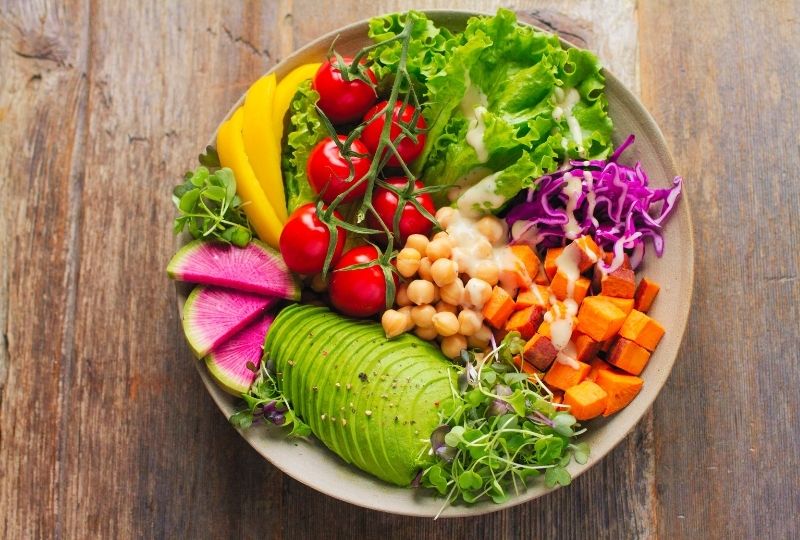Eating healthy doesn’t have to be complicated, restrictive, or stressful. Many people associate a balanced diet with strict rules and deprivation, but the truth is that healthy eating is about balance, not perfection.
By making simple, sustainable choices, you can enjoy nutritious meals, improve your well-being, and still indulge in your favorite foods—without guilt.
In this guide, you’ll learn how to create a balanced diet, avoid common mistakes, and make healthy eating a natural part of your lifestyle.
What Does a Balanced Diet Mean?
A balanced diet provides your body with the right amount of:
✅ Macronutrients – Carbohydrates, proteins, and fats.
✅ Micronutrients – Vitamins and minerals.
✅ Hydration – Sufficient water intake.
The goal is to fuel your body with the right nutrients while maintaining flexibility and enjoyment.
10 Practical Tips for a Balanced Diet
1. Focus on Whole, Unprocessed Foods
Whole foods are nutrient-dense and naturally support your health.
✅ Examples of Whole Foods:
- Fruits and vegetables 🍎🥦
- Whole grains (quinoa, brown rice, oats) 🌾
- Lean proteins (chicken, fish, beans, tofu) 🐟
- Healthy fats (avocado, nuts, olive oil) 🥑
❌ Avoid highly processed foods with excess sugar, artificial additives, and unhealthy fats.
2. Follow the 80/20 Rule
A balanced diet doesn’t mean perfection. The 80/20 rule encourages eating nutritious foods 80% of the time and enjoying indulgent foods 20% of the time.
✅ Why It Works:
- Prevents feelings of restriction.
- Allows you to enjoy treats without guilt.
- Supports long-term sustainability.
3. Eat a Variety of Nutrients
Each food group provides unique benefits, so aim for diversity in your meals.
✅ Build a Balanced Plate:
- ½ plate → Vegetables & fruits 🥕🍓
- ¼ plate → Lean protein (chicken, fish, tofu) 🥩
- ¼ plate → Whole grains (quinoa, rice, whole wheat) 🍚
- Healthy fats → A drizzle of olive oil or handful of nuts 🥜
4. Avoid Extreme Diets and Quick Fixes
Fad diets often lead to nutrient deficiencies, cravings, and burnout. Instead, focus on sustainable changes that fit your lifestyle.
✅ Example: Instead of cutting out carbs completely, opt for complex carbs like sweet potatoes and whole grains.
5. Control Portion Sizes Without Obsessing
Portion control helps prevent overeating while allowing you to enjoy your favorite foods.
✅ Practical Tips:
- Use smaller plates to avoid oversized portions.
- Eat slowly to give your brain time to recognize fullness.
- Listen to your hunger cues—eat when hungry, stop when satisfied.
6. Stay Hydrated Throughout the Day
Hydration is essential for digestion, energy levels, and brain function.
✅ Tips to Drink More Water:
- Start your day with a glass of water.
- Carry a reusable water bottle.
- Infuse water with lemon, cucumber, or mint for flavor.
7. Balance Carbs, Protein, and Healthy Fats
Each macronutrient plays an important role:
- Carbs → Provide energy (choose whole grains).
- Protein → Supports muscle growth and keeps you full.
- Healthy fats → Support brain function and hormone balance.
✅ Example of a Balanced Meal: Grilled salmon with quinoa, steamed broccoli, and avocado.
8. Plan and Prepare Your Meals in Advance
Meal planning helps you make healthier choices, save time, and avoid processed fast food.
✅ Simple Meal Prep Ideas:
- Cook a batch of brown rice or quinoa for the week.
- Pre-cut vegetables for quick salads or snacks.
- Prepare overnight oats for a healthy breakfast option.
9. Reduce Sugar and Processed Foods (But Don’t Eliminate Them Completely)
Too much sugar can lead to energy crashes, cravings, and weight gain.
✅ Healthier Swaps:
- Replace soda with sparkling water + lemon.
- Choose dark chocolate instead of milk chocolate.
- Use honey or cinnamon instead of refined sugar in recipes.
10. Eat Mindfully and Listen to Your Body
Mindful eating helps you enjoy food fully, prevent overeating, and improve digestion.
✅ How to Eat Mindfully:
- Slow down and chew thoroughly.
- Avoid distractions (TV, phone, or work while eating).
- Recognize real hunger vs. emotional eating.
Common Myths About Healthy Eating
🚫 “Carbs make you fat.” → Healthy carbs like whole grains and fruits are essential for energy.
🚫 “Eating fat is bad.” → Healthy fats (avocados, nuts, olive oil) support brain health.
🚫 “You need to eat ‘clean’ 100% of the time.” → A balanced approach is key to long-term success.
Final Thoughts
Healthy eating is not about perfection or restriction—it’s about balance, variety, and sustainability.
Start with small, realistic changes, such as adding more whole foods to your diet and staying hydrated. Over time, these small steps lead to lasting improvements in your health and well-being.
Ready to start? Choose one or two tips from this guide and begin your journey toward a balanced, stress-free diet today!
